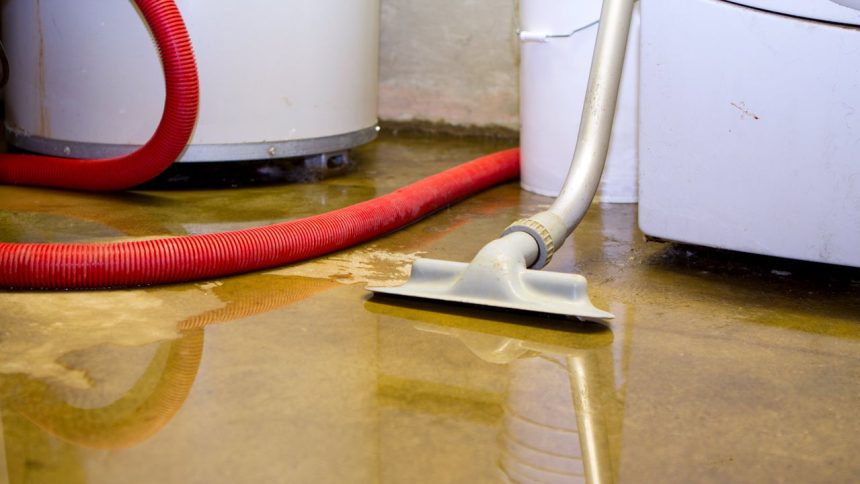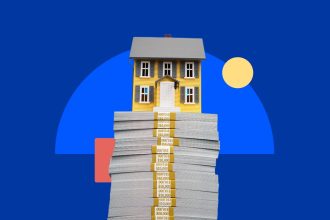Regardless of its age or location, no home is immune to water damage. From frozen pipes to leaky appliances to faulty sprinkler systems and more, water can be destructive, and repairs are often costly. According to the Insurance Information Institute (Triple-I), the cost of water damage to homeowners between 2017 and 2021 averaged $12,514. What’s worse, this type of damage is common. U.S. property owners report around $20 billion in water-related damage each year.
Luckily, homeowners insurance helps cover a wide range of misfortunes, including some types of water damage. But it’s important to be aware of which incidents are covered under your policy and which are not — before it’s too late. Here’s what you need to know.
Does home insurance cover water damage?
So when does homeowners insurance cover water damage, exactly? It depends on what caused the water damage. Damage caused by a burst pipe is typically covered, as long as the damage is sudden and accidental, and the homeowner has taken proper steps to prevent issues. For example, if your pipe freezes and bursts, it’s likely the water damage is covered under insurance (minus your deductible). However, if you leave your home for several days and turn off the heat during freezing temperatures, your insurer could have cause to deny your claim.
How coverage applies gets even more complex, though. A major dishwasher leak could be covered — or not. It all depends on the maintenance you’ve performed up to that point. If you knew the dishwasher was having issues and didn’t deal with it, your insurer could argue that you were negligent and the water damage could have been prevented, which means your claim would be denied. It’s also important to review the “Duties in the Event of a Loss” section of your homeowners insurance policy to understand what to do to prevent further damage should a claim situation occur.
Note that flood damage is almost always excluded under a standard homeowners insurance policy. You’ll generally need a separate flood insurance policy for this type of coverage.
What type of water damage is covered by homeowners insurance?
HO-3 policies are the most common homeowners insurance policies on the market. They typically include open perils coverage for your dwelling and detached structures, meaning if your house or garage is damaged by water it will likely be covered — unless your policy specifically excludes that peril. Under the HO-3 policy form, personal property coverage usually accounts for 16 named perils. The peril has to be listed in your policy to be considered a covered claim.
While your homeowners policy will cover water damage in many cases, it’s important to understand what scenarios are covered under your policy and in what scenarios your claim could be denied.
Rain and flood
We usually first think of rainfall and flooding when we imagine water damage. Does homeowners insurance cover water damage from rain? If it’s storm damage, generally yes. But does home insurance cover floods? Almost always, no.
If a storm breaks a window and rain damages the furniture and sheetrock in your living room, your dwelling coverage will usually pay for the repairs to your walls and floor, subject to your deductible and limits. Likewise, your personal property coverage will usually cover your furniture.
However, if your roof leaks while it is raining, resulting in damage to your furniture, your claim will likely be denied if the roof is old and shows signs of neglect. Claim adjusters can spot damage that has happened slowly over time and keeping up with standard household maintenance is part of being a homeowner. Damage from wear and tear or deteriorating property is a standard homeowners insurance exclusion.
Standard home insurance policies also don’t cover flood losses. Floods (along with earthquakes) are almost always specifically excluded from home insurance policies. So if those heavy rains lead to water pooling in your house, your standard policy won’t cover the damage. Homeowners can purchase flood insurance through the Federal Emergency Management Agency’s National Flood Insurance Program.
Overflow of appliances
In most cases, your dwelling coverage will pay to repair damages caused by an overflow of water from appliances, but only when the overflow occurs accidentally and suddenly. For instance, if a sock somehow blocks your washing machine’s water outflow hose and floods your laundry room, your dwelling coverage should cover the ensuing damage. If the water damages other items in the laundry room, like a dryer or cabinets, your personal property coverage should cover the losses.
However, your homeowners policy won’t cover water overflow from appliances if your own neglect led to the problem. For instance, if you remove your washer’s drip pan, make a conscious decision not to replace it and water destroys your floor over a period of months, the insurer is unlikely to pay for the damage.
Leaking pipes
When a pipe suddenly springs a leak or breaks due to an accident, your first thought upon discovering the mess will probably be about whether or not your homeowners insurance will cover the damage. Good news: if the cause of the damage was sudden and accidental, your insurance coverage should apply.
For instance, if you reach for a heavy iron skillet under your sink and crack a pipe while pulling it out of the cabinet, you should have a covered loss, and your claim would likely be honored. Under the same circumstances, your personal property coverage should pay to replace or repair items such as rugs. If damage to your cabinets occurs, your dwelling coverage should repair or replace them.
But if slow-leaking pipes cause damage due to improper maintenance, the insurer will likely deny the claim. For example, the insurance company can deny your claim if a leaking pipe worsens and results in long-term damage such as mold or wet/dry rot.
Extinguishing a fire
In most cases, your dwelling and personal property coverages will pay for water damage resulting from extinguishing a fire. If a grease fire destroys your kitchen and water used by firefighters rushes into your living room, destroying flooring, furniture and sheetrock, your policy should cover the damages.
But if negligence led to the fire starting, the insurer may not cover the fire or water damage. For instance, if your stove was previously inspected and the inspector noticed a hose was old, worn out and needed to be replaced, and you failed to do so, the insurer may deny the entire claim due to negligence.
Sewer backup
We’ve already discussed some direct impacts of sewer backup above, but there’s another piece to consider. What if water from a sewer or outside drain backs up into your house after heavy rain?
Generally, water or sewer backup is not covered in a standard home insurance policy. However, most insurance companies will offer an optional sewer backup endorsement. Some insurance agents may recommend this coverage if your home has an older plumbing system, or you have a basement or living area below ground level.
How to file a water damage insurance claim
When water damage occurs, you need to take a few steps before you file a claim:
- Prevent additional damage by stopping water flow at the source. If a pipe bursts, shut off the water immediately.
- Make temporary repairs. If a storm breaks your living room window and incoming rain damages your furniture, cover the window with a piece of plastic sheeting to minimize the damage. In some cases, you may need to contact a contractor to make more extensive temporary repairs.
- Remove all wet and ruined items but do not throw them away, because you will need them when you file a claim as evidence of the damage.
- Remove excessive water. You may need to rent a water vac to remove standing water in some cases. Thoroughly dry affected areas to prevent mold.
- Move undamaged personal items to a safe place.
- If the damage was prompted by illegal activity, call the police and file a report.
After you’ve taken steps to secure your belongings and prevent further damage, it’s time to start preparing to file an insurance claim:
- Take a detailed inventory of all damages to your home and belongings. Take photos or videos — closeup and wide-angle — of all affected structures and personal property.
- Collect receipts associated with the incident to include them in the claim. For example, if you purchase a tarp to cover a hole in the roof, you can include the expense in the homeowners claim.
- Contact your insurance carrier to file a claim. Claims filing varies by insurer. Some providers allow you to file claims online or using a mobile app, while others prefer you contact a claims center or agent.
- Complete all claims documents and file them within the allotted time. Include photos, receipts and videos with your claim.
- If the disaster renders your home uninhabitable, your policy includes loss of use coverage to help cover expenses such as temporary housing and meals. Keep all your receipts to include with your claim.
- Schedule an appointment with a claims adjuster. The adjuster will thoroughly inspect the damage to determine its cause and how much the insurance company will pay for your claim.
How to prevent water damage
Performing regular home maintenance is the best way to prevent water damage:
- Inside and outside your home, seal all windows to prevent water seepage.
- Remove any trees with roots that may interfere with the underground aqueduct system.
- Angle the soil in any planting beds that border your house downward to prevent standing water and direct rainwater runoff away from the structure.
- Install gutter guards to prevent debris from blocking water flow. Remove debris from downspouts and position them to divert water away from your house.
- Regularly inspect your roof for damaged or missing shingles. For newer roofs, hire a professional roof inspector every five years. Older roofs should be professionally inspected every one to two years.
- Check exposed pipes for signs of cracks or leaks. Repair or replace damaged pipes immediately.
- Inspect hoses that connect to appliances such as refrigerators and washing machines. Replace worn-out and damaged hoses immediately.
- Seal showers and tubs to prevent water leakage.
- If you live in a cold climate, install an emergency pressure release valve to the plumbing system to prevent pipes from bursting during winter’s frigid temperatures.
- Know the location of your main water valve and shut it off when a problem arises.
- Before leaving home for vacation, shut off the water supply to refrigerators and washing machines.
- Pay close attention to your water bill for drastic increases in water use. Excessive water usage could indicate a potential problem in your plumbing system.
Frequently asked questions
-
-
To help substantiate your water damage claim, the first step is to take several photos or videos of the water-damaged areas of your home. If the water damage has ruined any personal items, it’s usually okay to remove them from the affected area, but do not throw them away. The claims adjuster will need to inspect them. You may also want to save any evidence of what led to the water damage, such as a broken pipe.
-
Standard homeowners insurance does not cover flood damage. Typically, you will need to purchase additional coverage, and not all insurance companies offer it. If you can not secure coverage through a private insurer, you can purchase flood insurance through the National Flood Insurance Program.
-
Generally, a homeowners insurance policy does not cover mold damage — it is expressly excluded from policies since regular household maintenance will prevent most mold from occurring. However, if a covered peril is the cause of the mold, you may have coverage. Some insurance providers offer optional endorsements that cover mold damage and mold remediation up to a certain dollar amount. If you’re concerned about mold damage, speak with your agent and evaluate what options are available with your provider.
-
Water damage caused by ice or snow is generally covered, but you will want to consider that there are several ways for moisture to enter your home — and some may not be covered by your policy. Damage caused from “the weight of ice and snow” is considered a named peril, and the resulting damage is often covered by homeowners insurance. Similarly, damage caused by ice dams along your roof is frequently covered by standard insurance. But if your roof has existing weaknesses and moisture from snow or ice seeps in, your policy may not cover the damage that results. Experts recommend having annual roof checks for this exact reason so you can be notified of unknown damage and stop a large claim from occurring.
-
Read the full article here
















